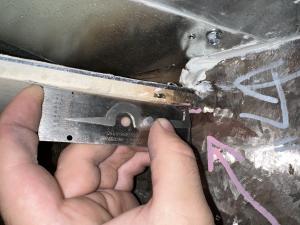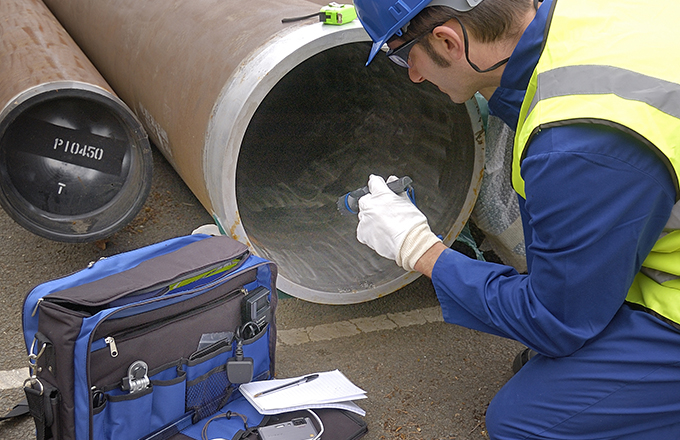Leading Tips for Effective Welding Inspection in Gilbert Arizona: A Comprehensive Guide
Leading Tips for Effective Welding Inspection in Gilbert Arizona: A Comprehensive Guide
Blog Article
A Comprehensive Overview to Welding Assessment: Understanding Requirements, Techniques, and Ideal Practices for Quality Control
Welding inspection plays a pivotal duty in guaranteeing the architectural stability and safety and security of welded components, requiring a thorough understanding of sector requirements such as those developed by AWS and ASME. As we check out these essential components, it ends up being evident that the ramifications of welding inspection prolong far past conformity, inviting a better assessment of just how these procedures shape industry criteria and methods.
Relevance of Welding Evaluation
Welding assessment plays an important function in making sure the stability and safety of welded structures. It is a necessary process that confirms that welds satisfy predefined specs, which is important in various industries, consisting of building and construction, automobile, and aerospace. By conducting complete inspections, possible defects such as cracks, insufficient blend, and porosity can be determined early, stopping devastating failings that could lead to mishaps or costly repair services.
The relevance of welding evaluation extends past simple compliance with regulations; it likewise fosters trust with stakeholders. Customers and regulative bodies anticipate assurance that the structures they rely upon are constructed to withstand functional stress and anxieties. Effective welding evaluation methods add to long-term sturdiness and performance of the frameworks, ultimately leading to decreased maintenance prices.
Additionally, welding assessment promotes a culture of high quality within organizations, urging adherence to ideal practices and continuous enhancement. By incorporating examination processes into the welding operations, companies can improve their reputation and establish themselves as leaders in quality control. Finally, the relevance of welding evaluation hinges on its capability to safeguard lives, guarantee structural integrity, and copyright industry criteria, making it an important aspect of welding procedures.
Secret Industry Criteria
Guaranteeing compliance with vital market requirements is important for preserving the top quality and safety and security of welded structures. Various companies develop these requirements to advertise ideal practices in welding and inspection - Welding Inspection Gilbert Arizona. Among the most recognized are the American Welding Society (AWS) and the American Culture of Mechanical Engineers (ASME), which offer detailed guidelines and specifications for welding procedures and examination standards
AWS criteria, such as AWS D1.1 for architectural welding, overview demands for materials, style, and screening to guarantee the integrity of welds. Likewise, ASME codes, including ASME Section IX, regulate the certification of welders and welding treatments, ensuring consistent quality in industrial applications. Worldwide, the ISO 3834 typical highlights quality demands for combination welding, giving a structure for organizations to demonstrate compliance with global best techniques.
Compliance with these standards not only improves the dependability of welded frameworks but likewise alleviates dangers associated with structural failings. Adherence to industry standards is typically a requirement for regulatory approvals and can substantially affect project specifications. Ultimately, understanding and carrying out these key standards are vital for reliable welding evaluation and quality control.
Examination Techniques Overview
Efficient welding examination counts on a variety of strategies made to evaluate the quality and honesty of welds. These techniques can be extensively categorized into devastating and non-destructive testing (NDT) techniques. Non-destructive testing methods, which are commonly favored in the industry, allow for the examination of welds without jeopardizing the integrity of the product.

Amongst the most commonly made use of NDT strategies are visual examination, ultrasonic testing, additional resources radiographic screening, and magnetic bit testing. Visual evaluation is typically the initial action in the analysis procedure, making it possible for inspectors to identify surface imperfections and evaluate weld bead accounts.
Each strategy has its very own benefits and restrictions, making it crucial for assessors to pick the most ideal technique based upon the certain demands of the project, the materials entailed, and the criticality of the welds being checked. This cautious choice upholds and makes sure extensive analyses safety and high quality requirements in welding procedures.
Common Problems and Their Effects
An extensive understanding of common problems in welds is crucial for preserving structural stability and safety and security in bonded building and constructions. Welding issues can considerably jeopardize the mechanical residential or commercial properties of the joint, resulting in failures that could threaten both employees and equipment.
Common flaws include porosity, which shows up as tiny gas pockets caught in the weld metal, weakening the total structure. Breaking is an additional common issue, commonly arising from quick air conditioning or inappropriate joint layout, leading to tension focus that can cause devastating failures. Insufficient combination takes place when the weld metal falls short to properly bond with the base material, creating weak factors that might lead to separation under tons.
Various other noteworthy defects include undercutting, where the weld grain erodes the base metal, and slag incorporations, which can impede the weld's stamina. Each of these issues has details effects; for example, porosity can minimize Check This Out ductility, while fracturing directly affects tensile strength. Recognizing and recognizing these defects throughout assessment is vital for executing corrective measures and guaranteeing conformity with market requirements, ultimately protecting the structural stability of welded settings up.
Finest Practices for Top Quality Assurance
Carrying out finest methods for quality control in welding procedures is important for achieving optimum results and decreasing issues. One important method is the facility of clear welding procedures that abide by industry criteria and specs. These treatments ought to include detailed directions regarding material option, joint preparation, and welding strategies to guarantee consistency and quality.
Routine training check and qualification of welding personnel are likewise important. Competent welders that recognize the importance of quality control are most likely to produce audio welds. In addition, carrying out a durable inspection program, including both visual and non-destructive screening (NDT), can help determine defects early while doing so, permitting for prompt rehabilitative activities.

Finally, promoting a culture of top quality within the company encourages workers to focus on quality in their work. By adhering to these finest techniques, organizations can boost the honesty of their welding procedures, ultimately resulting in boosted product high quality and minimized prices connected with rework and fixings.

Conclusion
To conclude, welding inspection plays an essential role in making sure the stability and safety and security of welded structures. Adherence to essential market criteria, such as those developed by AWS and ASME, is necessary for efficient high quality assurance. Employing different examination methods enables the recognition of usual defects, consequently reducing potential risks. By applying ideal techniques, companies can improve dependability, lessen upkeep costs, and grow count on among clients, ultimately adding to effective welding procedures - Welding Inspection Gilbert Arizona.
Additionally, welding examination advertises a culture of quality within companies, urging adherence to ideal methods and continual improvement. In verdict, the value of welding evaluation lies in its capacity to secure lives, make sure structural reliability, and support industry standards, making it an essential facet of welding procedures.
Amongst the most recognized are the American Welding Culture (AWS) and the American Society of Mechanical Engineers (ASME), which offer comprehensive guidelines and specifications for welding processes and assessment criteria.
Inevitably, understanding and applying these key standards are crucial for effective welding assessment and quality guarantee.
Reliable welding assessment counts on a variety of methods developed to assess the top quality and stability of welds.
Report this page